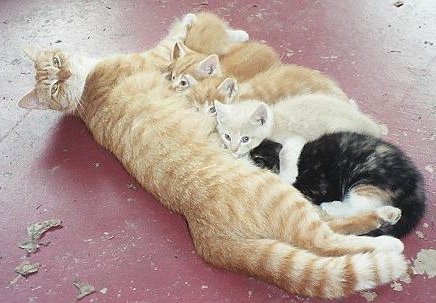The life of a kitten - early development
A domestic mother cat has a pregnancy lasting about 63 days. This is another sign of how late cats were domesticated, as the length of the pregnancy is very much on par with that in wild cats. For example, Felis Silverstris has a gestation period only slightly shorter at 56-60 days, whilst another wild cat, the black-footed cat (Felis Nigripus) takes up to 68 days to produce its young.
When a domestic kitten is born it weights approximately 100g (though your poundage may very depending on the breed). Since an average cat grows to about 4.5 kg, this means that kittens start with about 2% of the body weight they will grow into. Cats are born with very little hearing and closed eyes, making them practically blind and deaf at birth. However their sense of touch (often called 'tactile sensitivity') is well developed even before birth. It is present in the embryo by day 24 of gestation, well before reflexes for example, which develop by about day 54 of gestation. Actually cats closely follow the development of most mammals, where the tactile senses develop first.
During the first two weeks of life, the kitten relies mostly on this tactile sensitivity, responding to the warmth of the mother's body (the 'thermal tactile'). The sense of smell has been present since birth and it is very important for a very young suckling kitten. Indeed, most kittens claim a single nipple for themselves and recognize it with ease, probably by smelling their own pheromones deposited around the nipple during suckling. Although the sense of smell is present at birth, it is hugely refined during the first three weeks of life. And an adult cat's sense of smell is formidable. By the time it is an adult, the kitten will have a huge number of cells which process smell (known as olfactory cells). Humans have between 5-20 million of these cells, kitty will develop 67 million.

Stay off my nipple
Hearing also develops early in a kitten's life. By five days the kitten starts to respond to the sound, but it takes another 10 days or so before the kitten can work out which direction the sound is coming from. Sound orientation is fully developed by about four weeks. So how good will the kitten's hearing become? Well, very good. There are few mammals with better hearing than cats. The kitten's hearing improves once it masters rotating its ears in the direction of a sound. A cat's ears can rotate by just over 180 degrees and the ears do it independently of each other. The rotation of the cat's pinna (the external part of the ear) requires getting control of over 20 muscles.
Next, sight. Although some kittens may open their eyes as early as two days, for the first two weeks most kittens are blind. Once the eyes start opening, it takes on average 2 to 3 days before both are fully open. Thereafter, the kitten starts using visual clues very rapidly. By the end of week three the kitten will use sight to identify its mother, though it will take another few days before the kitten is clear enough about what it is seeing to be able follow mother around. Even then it will take another few days before the kitten is clear about where to put its feet and how to avoid walking into things. By about day 35 the kitten's eyesight will probably be as good as yours in all but colour perception. And it keeps improving during the next six weeks. For example, the fluids in a kitten's eye become completely clear only after about 5 weeks. Eventually eyesight will improve about 16-fold in the first 10 weeks fafter the eyes first open. A cat's eye, like any mammal's eye, is a very complex machine, but the kitten will develop two important elements which give it the edge on most mammals in the visual department. The first is the pupil. In reduced light these expand into a large circle, practically filling the eye. Secondly, the cat's eye has a series of highly reflective layers of proteins containing zinc at the back of the retina which works as a highly refined image intensifier. As a result a cat can see easily in 1/6 of the light A human needs.
Finally there body temperature control and bodily co-ordination. As mentioned earlier, thermal sensing is already developed in a newborn kitten, so even a one day old is capable of moving in the direction of something warm. Because the kitten's metabolism is not good at controlling body temperature, by picking the warmth of what it cuddles up to the kitten regulates its body temperature by external means. By three weeks, the metabolism has adjusted to some degree and by seven weeks body temperature control is as good as in adults.
In their first two weeks, kittens are not very mobile. They can get about with slow paddling motions, but they certainly cannot walk. They attempt their first unsteady steps when they are about three weeks old, but they do not move very far from the nesting site. Short (sometimes comically unsuccesssful) attempts at running are seen in kittens which are six to seven weeks old, but the complex skills, for example for elegantly strolling along the top of a narrow plank fence are achieved with success after about 10 to 11 weeks. This is about the age when the motor function is near its maturation. These motor skills are encouraged by the mother, who tolerates kittenish attacks on her flicking tail, and (often to the distress of humans whom she adopts) by bringing carefully pre-crippled mice home for the 'kittens' to practice on.
